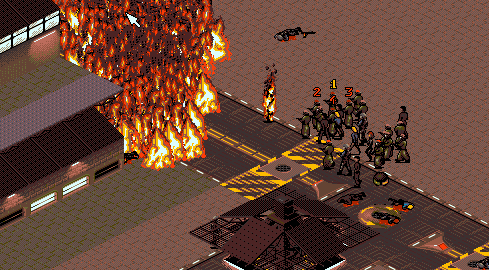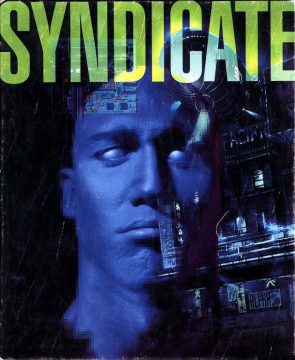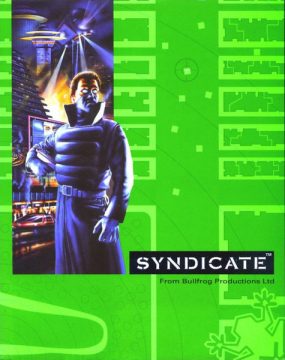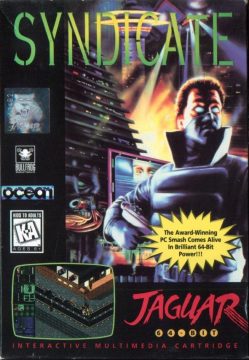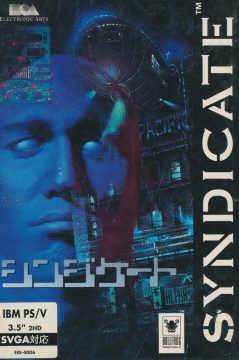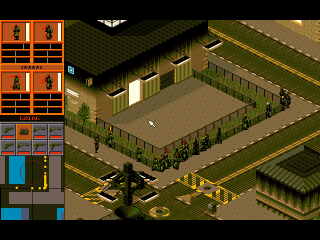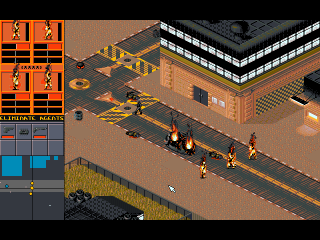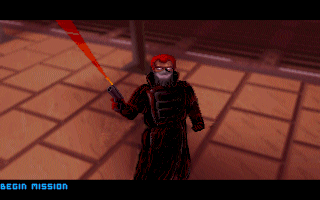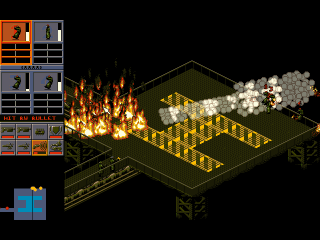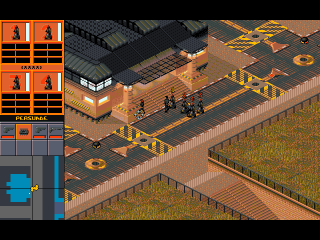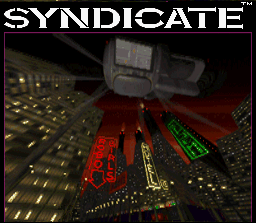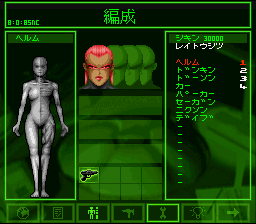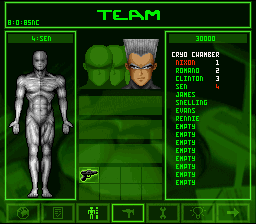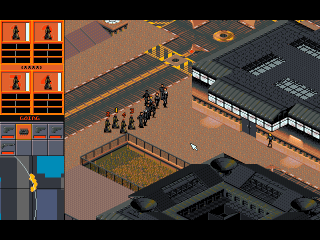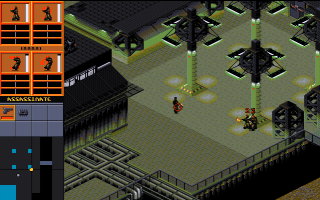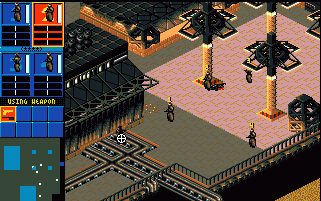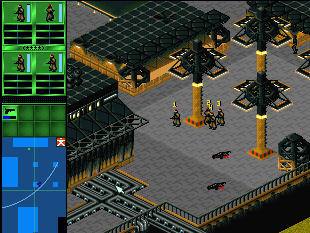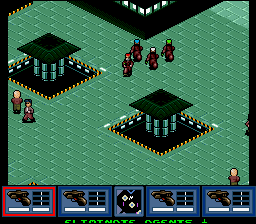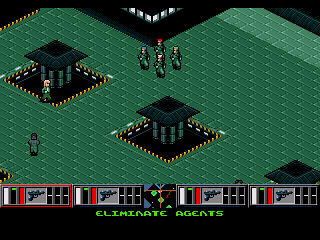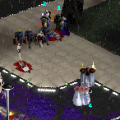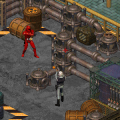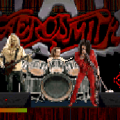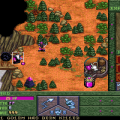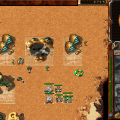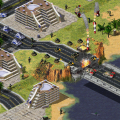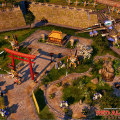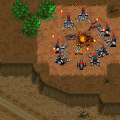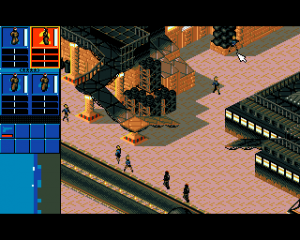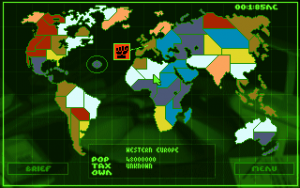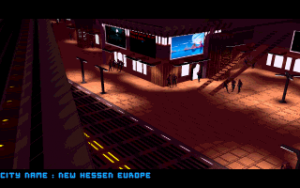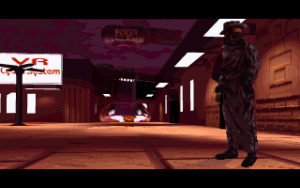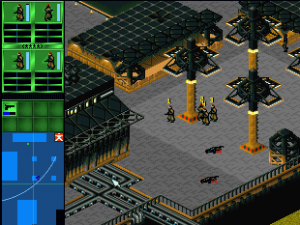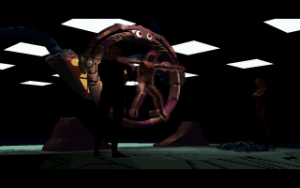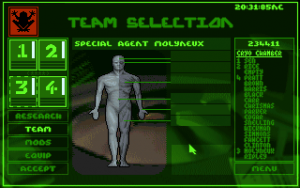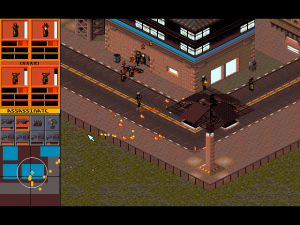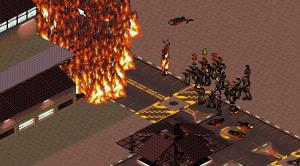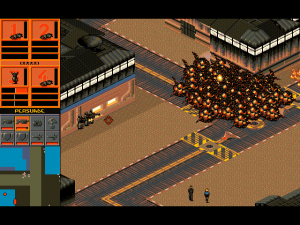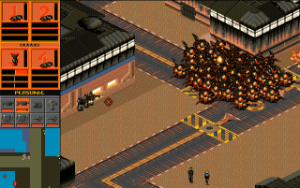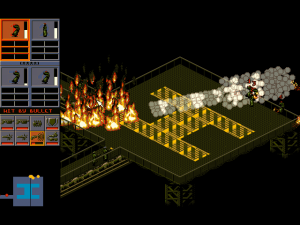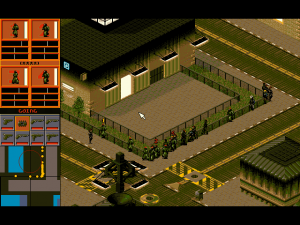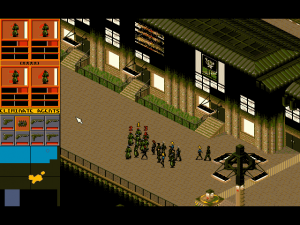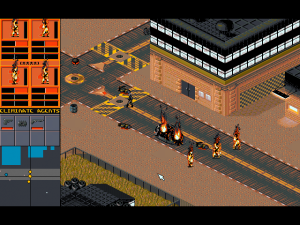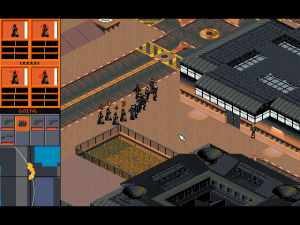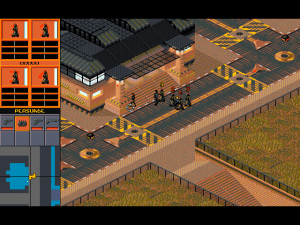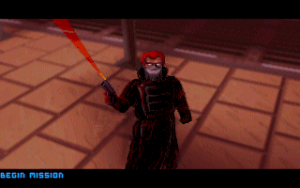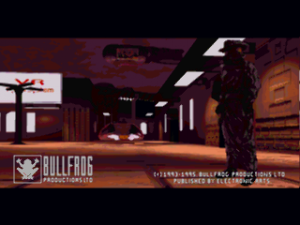- Syndicate
- Syndicate Wars
How does one take over the world, exactly? Legions upon legions of spy films and role playing games have suggested all kinds of nefarious schemes, yet Bullfrog’s Syndicate is probably closer to reality than anyone would like to admit. Your job, as the head of a massive corporation larger than any government, is to slowly spread your influence over world, country by country, and oversee humanity from the shadows. You aren’t the only ones either, because rival corporations have the same exact idea you do. As an executive, combat isn’t fought directly, but rather by controlling a small contingent of heavily armed cyborgs through each major city, killing other agents, assassinating targets, and kidnapping people of importance. “Corporate persuasion through urban violence”, is Syndicate‘s motto.
Syndicate is broken up into two segments – the simulation portion and the action portion. The simulation portion gives you a view of the whole globe and lets you pick your next territory, essentially a fancy level select. Once you’ve obtained your briefing, you can select four of your cyborg agents out into the fields. Initially, you’re short on cash, and they’re ill-equipped, wielding measly pistols. As you progress through the game and take over various countries, you control their tax rate, which in turn gives you more money. You can them spend it on various cybernetic upgrades – buy some new legs to make your agents walk faster, or give them a titanium body to absorb more damage. In addition to finding weapons in the field, you can buy your own too, although new weapons are usually obtained through research. Developing new technologies takes time, but the more cash you pump into a project, the faster it’ll get done. The whole game operates in real time, which actually leads to some interesting work-arounds – if you can beat enough territories to gain a positive cashflow, you can simply set items to research and then leave the game idle for a few hours, letting you rack in the dough while upgrading your arsenal. Compared to titles like X-COM, though, the simulation aspects are remarkably straightforward and not too intimidating, despite the awkwardly structured interface.
Once you enter a mission, the action switches to an isometric viewpoint, as you guide your trenchcoat-clad agents through the city. The goals are simple – kill certain targets, eliminate all enemies, kidnap certain people, or escort certain people. Syndicate is usually labeled a real time strategy game, although that’s only partially true. It does play a lot like Warcraft and Command & Conquer, in that you control your squad via the mouse, but outside of the interface similarities, it’s much more of an action game – in fact, a better parallel would be Sensible Software’s Cannon Fodder. Although you left click to tell your agents where you go, you actually aim and fire via the right mouse button, as opposed to simply clicking on the enemy you want to attack, like most RTSes. This makes for a game that’s much more focused and hands-on, because it’s rare that you’ll ever want to make your agents split up.
Indeed, even if you wanted your agents to travel their separate ways, the interface will probably end up getting in your way. There’s a noticeable lack of feedback when issuing orders – your agents say some kind of robotic speech when selected (it sounds like “JELAKIT”, but who knows, really), but there’s no indication or confirmation when you tell them to move. Similarly, unlike normal RTSes, you can’t just click on the character you want to control, or draw a lasso around them – instead, you need you select their portraits on the left side of the screen, or use a keyboard shortcut.
Generally it’s just much easier to just guide all four agents at once, although this significantly reduces the “strategy” involved. Most of the time it’s just easier to wander through the map and then hit the panic button whenever attacked. At this point, the game really boils down to (A) having a full arsenal and fully upgraded characters, and (B) a damn quick trigger finger. This is absolutely essential for the final level, the Atlantic Accelerator (a fictitious island in between North America and Europe), where you’ll almost immediately bum rushed by enemy agents, all wielding the most powerful weapons.
In many ways, Syndicate is a precursor to Grand Theft Auto. While each of the cities are self-contained, giving the game more structure, your agents are free to explore the city at their leisure. It’s full of civilians, walking around and essentially minding their own business, as well as police officers, who will shoot your men down if they happen to see them with a weapon out. The city is also filled with hovercars, which drive around the city, stop for pedestrians and traffic signs, and can also be carjacked to make transportation much faster. Like GTA, much of the enjoyment simply comes from the extraordinarily random amount of violence to be caused, especially once you get the more powerful weapons. Throughout the game, you’ll find shotguns, Uzis, flamethrowers, Gauss guns (fancy rocket launchers) and other bits of mayhem. You can also pump them full of three different kinds of drugs, which enhances their speed and reaction time. You can’t use them too often, though, because eventually they’ll grow tolerant of them and won’t have the same effect, requiring you to reel back on their dosage for a few moments. Mastering this is essential, because otherwise your guys walk very, very slowly. It’s perhaps a bit sociopathic, but taking a flamethrower to a group of random civilians to watch them flail around on fire, then firing rockets at every car in sight is a fine stress reliever, and is sometimes more fun than actually playing the missions.
A large chunk of this has to do with a nifty item dubbed the Persuadertron. Watching a James Bond film, one always has to wonder – how is the evil villain able to employ his henchmen? Syndicate answers that question quite nicely. All of your agents are simply kidnapped and brainwashed – the animated intro shows your agents yanking some guy off the streets, taking him to your headquarters, having him stripped of his organic limbs in favor of robotic ones, and plonked back out onto the street to do your bidding. In game, when you equip a Persuadertron, walk next to an NPC and it’ll convince them to mindlessly follow your agents around. Although you can’t directly control them, they can pick up guns from fallen enemies, and will shoot whenever you shoot. It’s not as easy as just walking up to any old person, though, as effective use of the Persuadertron requires a bit of peer pressure. Average civilians can be brainwashed immediately, but the tougher units – policeman and enemy agents – require more convincing. Therefore, you need to amass an army of roughly a dozen regular folk to persuade a policeman, and more to capture an enemy agent. Although most of the masses are useless, any surviving enemy agents are added to your own pool of employees, allowing you to use them for future missions.
Other interface quirks and annoyances dominate the whole game. The radar, for instance, focuses on the selected agent instead of the camera. Sometimes you’re given directions to find specific targets, but on other occasions – the ones where you just need to kill all enemy agents – require stumbling around the entire map, unless they’re proactive enough to hunt you down themselves. The pathfinding AI is beyond abhorrent. If you expect to guide your agents any more than a screen, you need to completely babysit them, lest they end up getting stuck on a roof of a building or otherwise lodged in the scenery. It’s extremely funny to find that your persuaded NPCs have gotten stuck on a set of train tracks and watch them stupidly get plowed through en masse. Vehicles are extremely difficult to steer, and since this is a British game, the fact that the whole world seems to drive on the left side of the road makes things more confusing. Since the camera is set at a static isometric angle, both agents and enemies tend to disappear being them. And it’s impossible to see anything whenever anyone goes indoors, requiring you to look at the radar or use the targeting cursor to feel around for targets.
Syndicate‘s visuals were inspired by Blade Runner, to an extent, with all of the floating cars and video billboard advertisements. Still, it’s a much brighter game, as each of the missions take place in broad daylight. Since the viewpoint is so zoomed out, the sprites are quite small, although it gives a better view of the action. There’s also no visual variation between any of the stages – the cities of Great Britian look practically identical to any of the cities in Africa or South America. There are only two songs that play throughout the game – the general exploration theme, and the action theme when your agents are in danger. They’re oppressively catchy, but like the visuals, the lack of variation makes the whole game feel somewhat samey.
Syndicate was initially released on the PC and Amiga, both on disk format. They’re largely the same, although the Amiga version has low-res graphics, while PC version has the benefit of hard disk installation and shorter load times, as well as high res graphics. Both are limited to 16 colors in game, though. The Amiga CD32 version, released four years after the disk version, is identical outside of the format, despite the promise of being enhanced.
The 3DO and Jaguar versions are mostly similar to the computer versions, with the same visuals, levels and interface. Obviously the control pad on both systems is hardly a substitute for a mouse, which makes pointing and clicking a bit of a pain. You also can’t access the sidebar, requiring the use of shortcut commands. This is easy enough on the Jaguar, as they’re mapped to the numeric keypad, but requires a bit of fancy combinations to get working on the 3DO. The 3DO did have a mouse peripheral, but for some reason, Syndicate doesn’t support it. The Jaguar version features the ability to zoom in or zoom out of the action, for a total of three different view levels. The close-up view is too pixellated, and the wide view is too small, so neither is really useful. Both have similar music and faithful sound effects, although the 3DO version has an extra song that plays during the mission planning scenes.
The 16-bit console ports are entirely different from these other versions. All of the graphics have been redrawn, and while they look comparable, the new sprites look too chubby to really take seriously. Instead of guiding a cursor, you control each agent directly, while targets are highlighted automatically when facing them. It’s not an ideal way to control the game, but it’s preferable to the alternative. The main problem comes with all of the secondary commands which, like the 3DO version, require a series of complicated button presses to change agents, equip or de-equip weapons, or administer the drugs. The levels are all completely different, and have some oddities, like robot drones that patrol the streets. The AI is even worse, as cars will often run right over your agents instead of stopping. At least the SNES version has some damn good renditions of the music. Electronics Arts released a package called EA Replay for the PSP which includes Syndicate, but it’s actually just an emulator running the SNES version.
The planning segments had a confusing interface in the PC versions, but they’re worse in all of the 16-bit ports, replacing all of the commands with nearly indecipherable icons. The SNES version actually has anime-style portraits, completely with colored hair and bizarre haircuts, on the character selection screen. Why, who knows – it appears to be the only version of Syndicate released in Japan, so maybe that bit was snuck in for them?
A Mega CD version was released only in Europe, and was actually one of the last games released for the platform in the territory, making it something of a collector’s item. It contains a fuller version of the PC intro (the Genesis cart had it but the animation was cut significantly) as well as a brand new CD audio soundtrack exclusive to this version. It’s quite nice and atmospheric, although otherwise it’s identical to the Genesis version. None of these 16-bit ports are really all that worthwhile and will mostly just prove frustrating to fans of the original.
An expansion disk called American Revolt was also released shortly after the game’s publication. Your syndicate has taken over the globe, and installed mind control chips in everyone but the whole American continent has started a revolution that needs to be silenced. Other than the basic plot, which is really only detailed in the manual, not much has changed, other than the new missions. All of them are extraordinarily difficult and the whole package is really only meant for those who’ve completely exhausted the original game. There’s a new multiplayer mode which can only be played over a network, and a new item for this called the Clone Shield. The only real addition to the single player mode are the airstrikes, which have more destructive capacity than even the Gauss gun. Both the original game and American Revolt were later bundled onto a single CD-ROM under the title Syndicate Plus.
